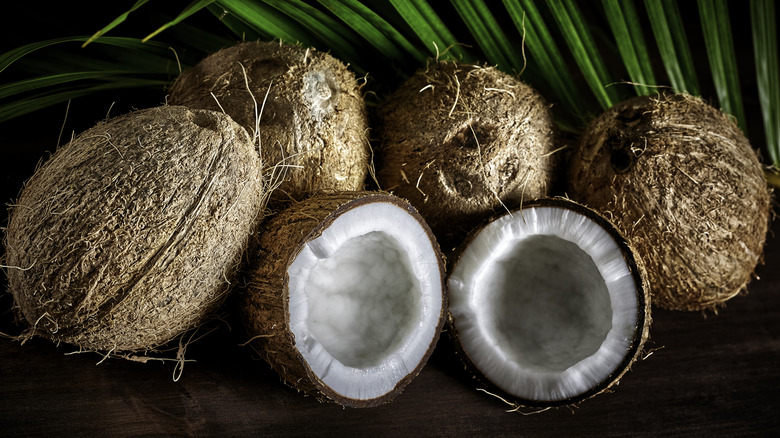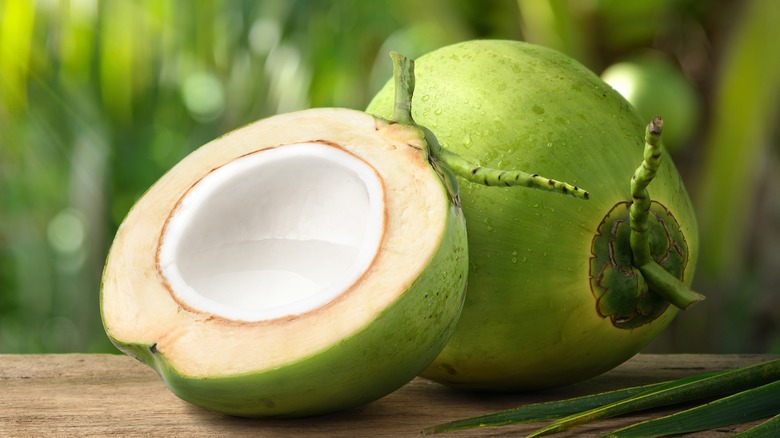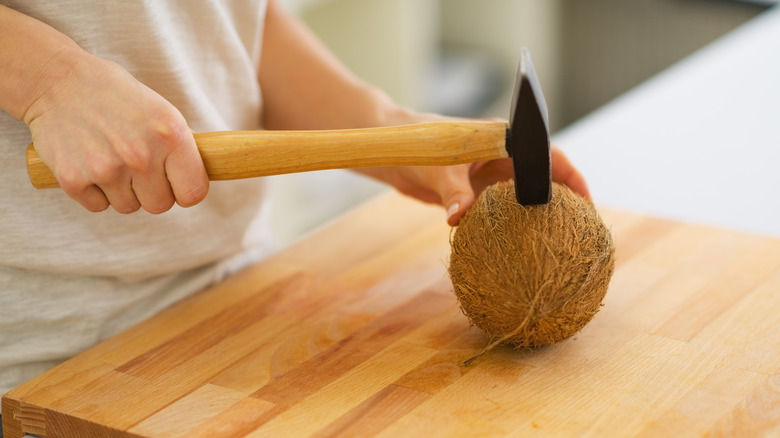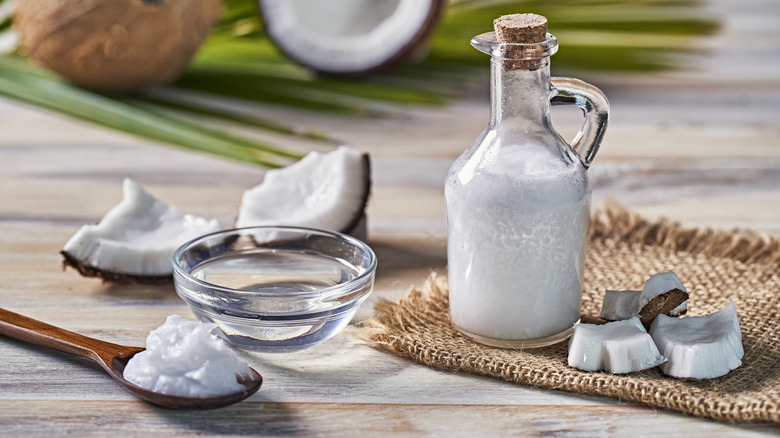How To Open A Coconut Without Losing A Finger
Depending on where you live and which markets you shop at, coconuts may not always be available. If you do find one, you may be tempted to grab a knife and just go at it as if it were some sort of winter squash, but there are easier — and safer — ways to open a coconut.
Young coconuts are sold green with the husk on or with the husk removed, in which case the white outer shell is exposed. They have rounded sides and a pointed top, so they kind of look like a yurt. Underneath is the inner shell which contains the meat and coconut water — this is the part of the fruit that will later harden into the recognizable hard, brown, fibrous, mature coconut. Mature coconuts will require a bit more brute force to get them open.
Whether you are opening a young or mature coconut, you will need to place it on a bunched-up kitchen towel so that it doesn't roll around. Keep in mind that both types of coconut are rather firm, so you should always make sure that your fingers are out of the way of whichever knife or tool (we suggest a butcher's knife or hammer) you are using. Then, you'll either cut a hole and drain the coconut before breaking it in half, or you'll open a little hat on top from which you can drink the milk and scrap out the flesh.
How to open a young coconut
To create an opening at the top to plunge a straw into, hold the base of the coconut with your non-dominant hand, and with a large cleaver, butcher's knife, or chef's knife in your dominant hand, firmly knock the pointed corner of the blade (not the tip) into the top of the coconut, just to the side of the point. With the right amount of force, you will have pierced both the outer and inner shells. Carefully rock the corner of the knife back and forth to make a cut, remove the knife, and repeat twice more to create a square opening — like at the top of a Jack-o-lantern. After three cuts, you should be able to pry off the top to create an opening.
Alternatively, trim off the soft outer shell as if you were cutting off the peel of a pineapple. You will eventually expose the three, round, bowling ball-like indentations called eyes. Two will be plugged, but one will be soft. Carefully, pierce the tip of the knife through the soft hole, and rotate the coconut in a circular motion to bore a hole. You can then tip out the coconut water. Then, hold the coconut securely and hit the back of the knife along the equator, rotating so that you strike all the way around the whole coconut — the young coconut should split right in half. Scrape out the soft flesh with a spoon, fork, or handheld coconut grater.
How to open a mature coconut
One method of opening a mature coconut is very similar to opening a young coconut. Use the back of a large knife or hammer to strike the coconut around the middle. If you don't have the patience, you can also just use your hands and slam it down on your cutting board. Once you crack open the coconut, coconut water will spill out, so have a bowl at the ready so you can hold the coconut over it and catch the water. You can also remove the water first by piercing the soft eye. Position a screwdriver in the indentation, tap it through the shell with a hammer, and then drain the water. Alternatively, use a corkscrew wine opener.
To pry the meat from the shell you will need to wedge a spoon, a butter knife, or a paring knife, between the flesh and the shell and use a whole lot of elbow grease. If you are willing to add one more step, you can make the flesh of the coconut easier to separate from the hard shell with heat. Bake the coconut halves in the oven, float them in simmering water on the stove, or soak them in hot water. Heat helps to separate the meat from the shell so you can pry it out more easily.
What to do with fresh coconut
The pieces of fresh coconut will have a thin layer of brown skin — this skin is totally edible and doesn't affect the texture much at all. If you are after a pure white look for whichever sweet or savory dish you are making, simply remove the skin with a vegetable peeler.
From the time it has been picked, a mature coconut will last up to around six months at cool room temperature, but that doesn't account for transportation time and how long it spent on the grocery store shelf. Once a coconut has been opened, it will last four to five days refrigerated. You can also freeze some to toss in smoothie bowls, desserts, stir-fries, or curries later on.
Now, how do you process the coconut that you worked so hard for? Shred or grate fresh coconut on a box grater or microplane, or shave it into strips using a vegetable peeler. You can also simply dice it with a knife or pulse it in a food processor to chop. Fresh coconut can be made into homemade coconut milk, cream, or oil, and don't forget about the water! Drink coconut water on its own, add it to smoothies and cocktails, or for soft, fluffy, coconut rice, choose water over milk.




